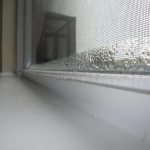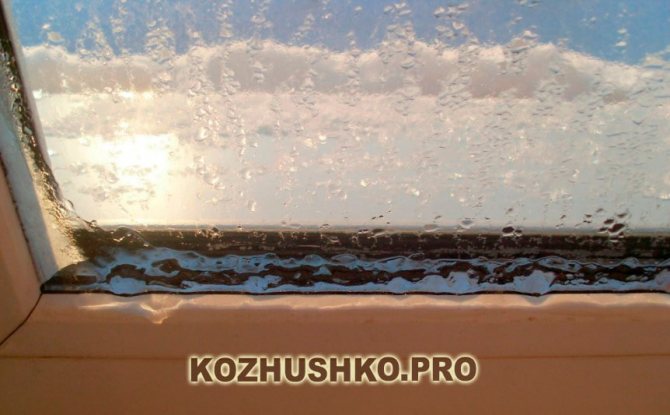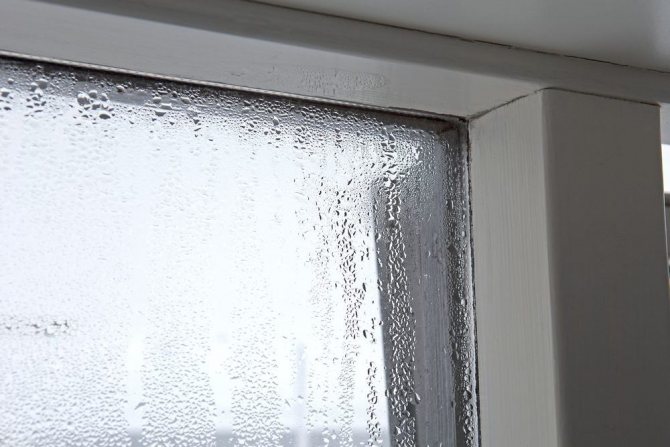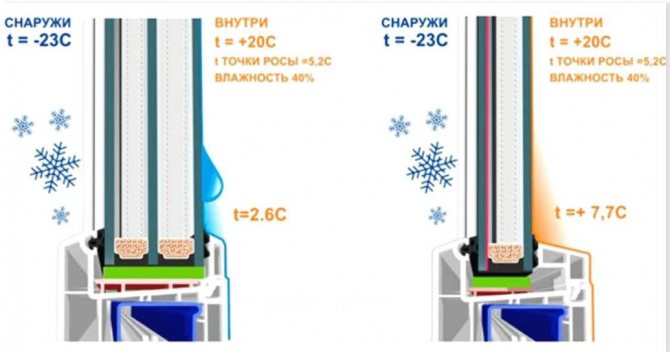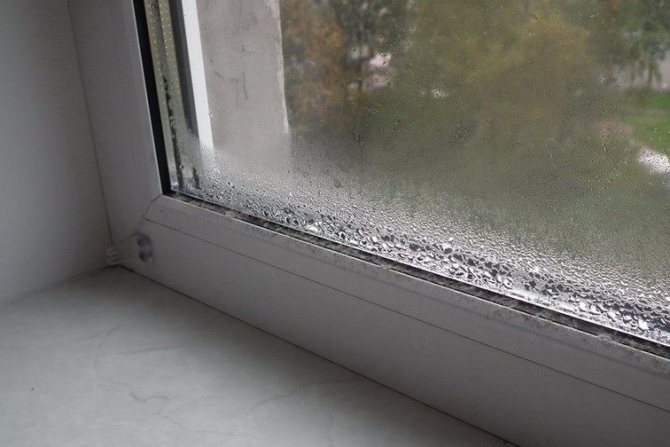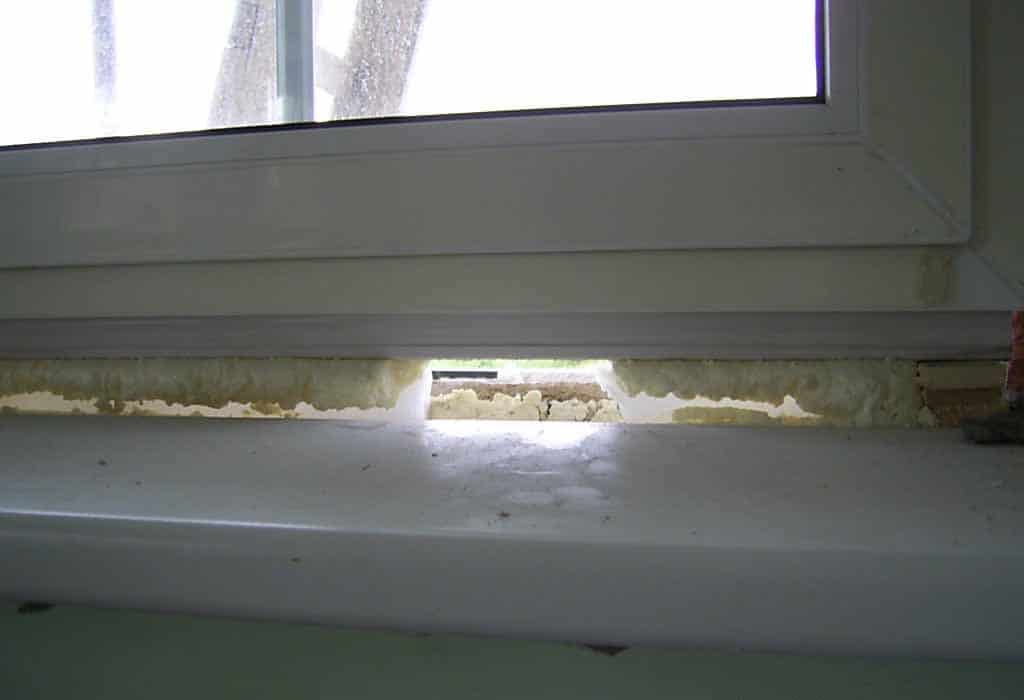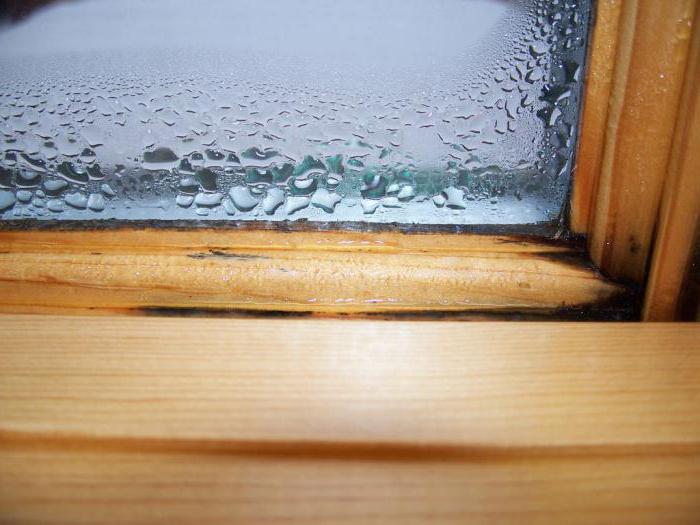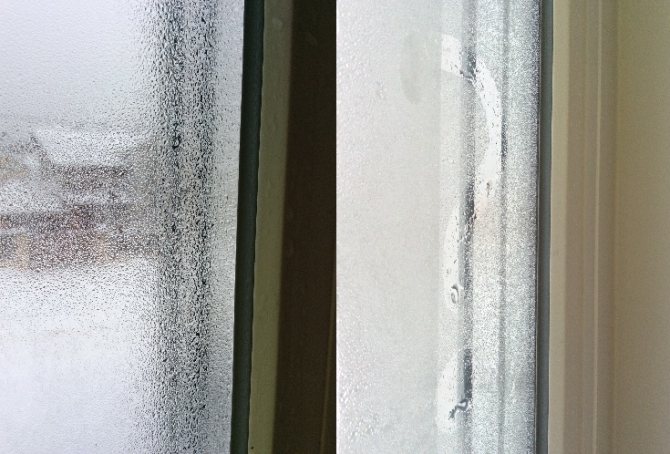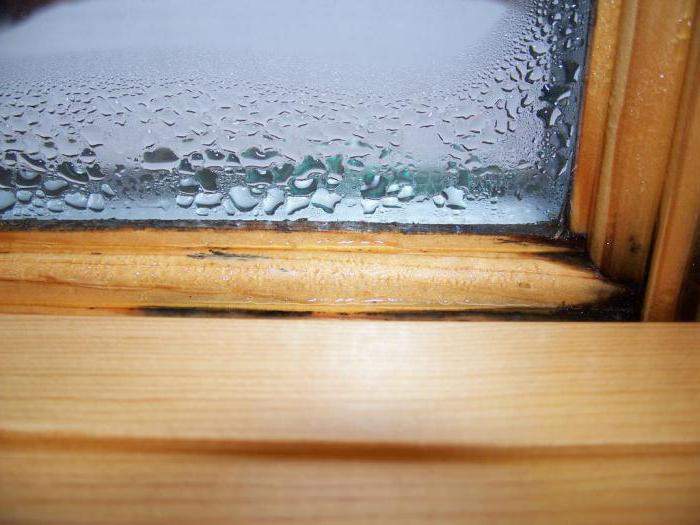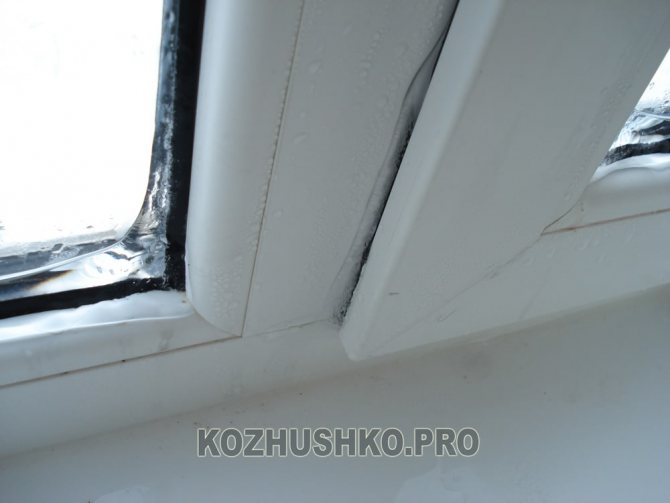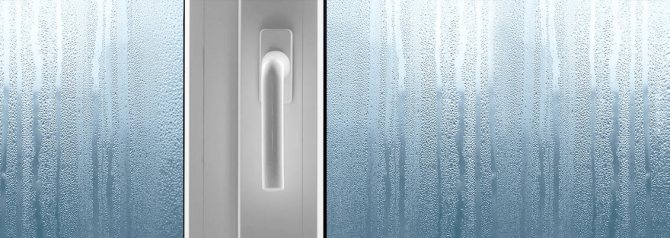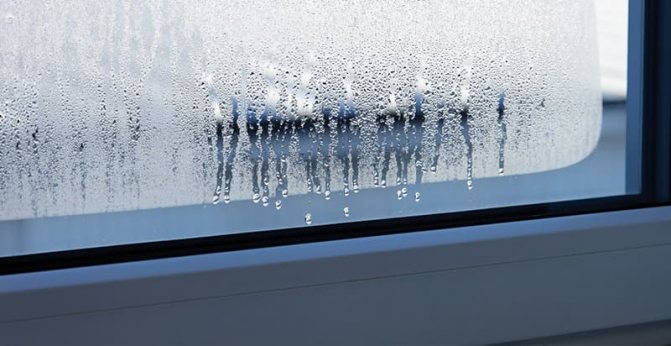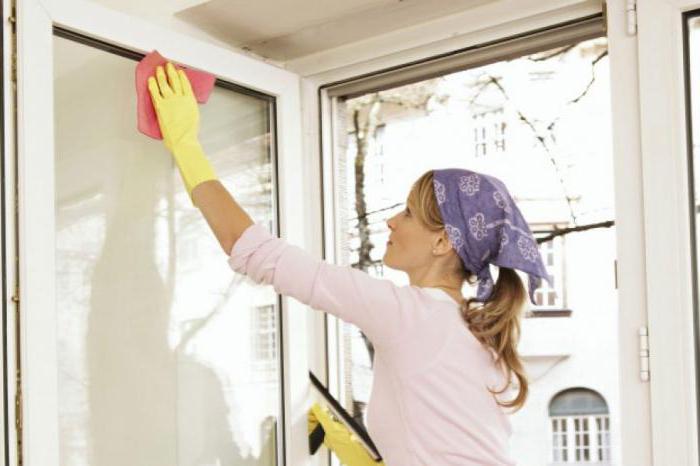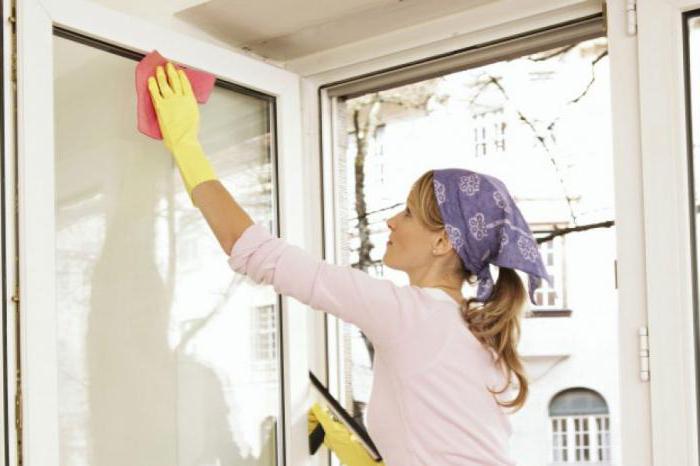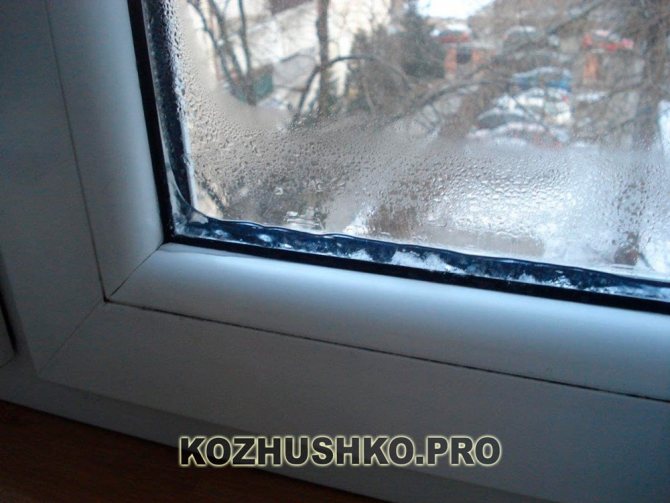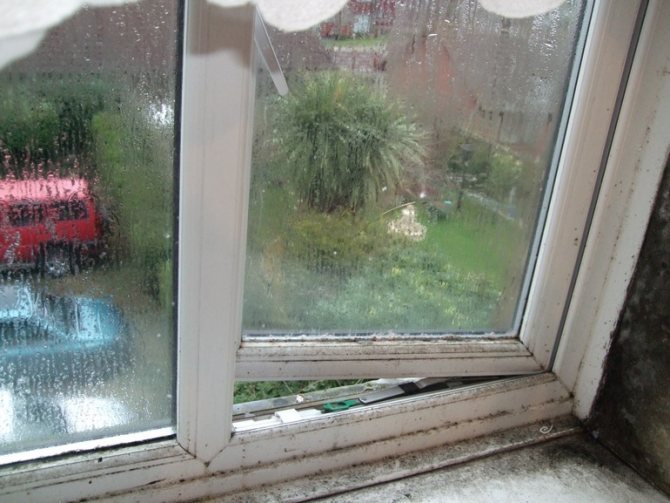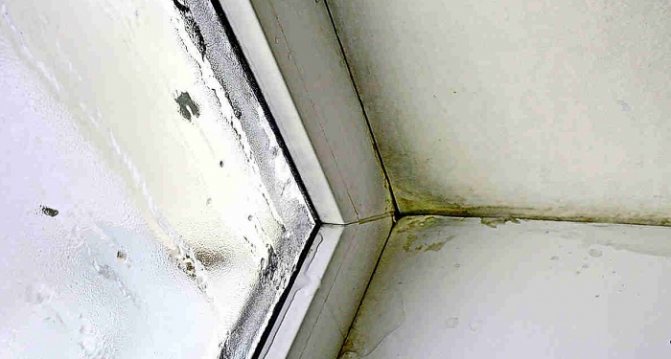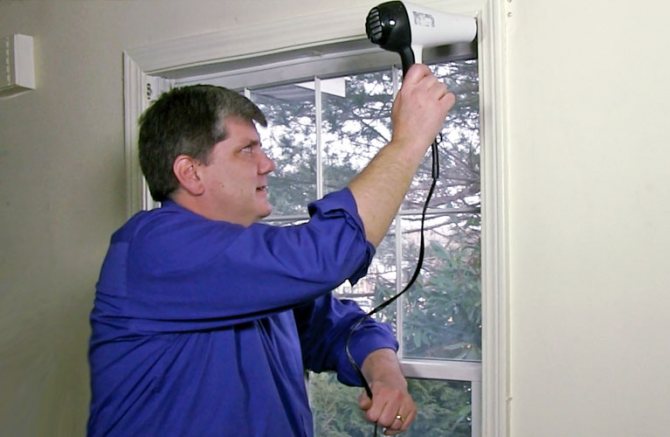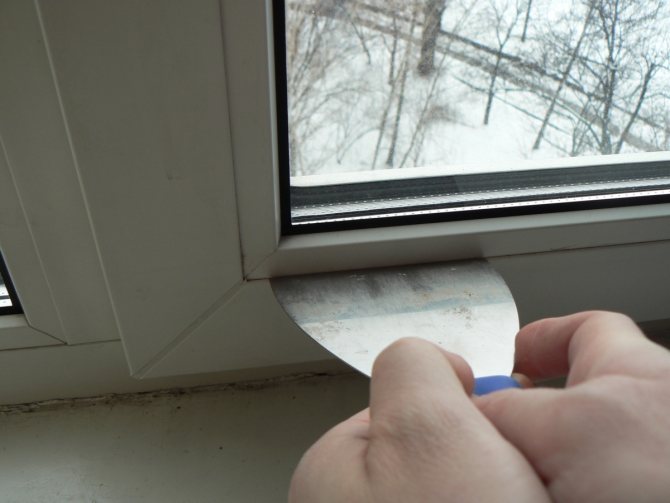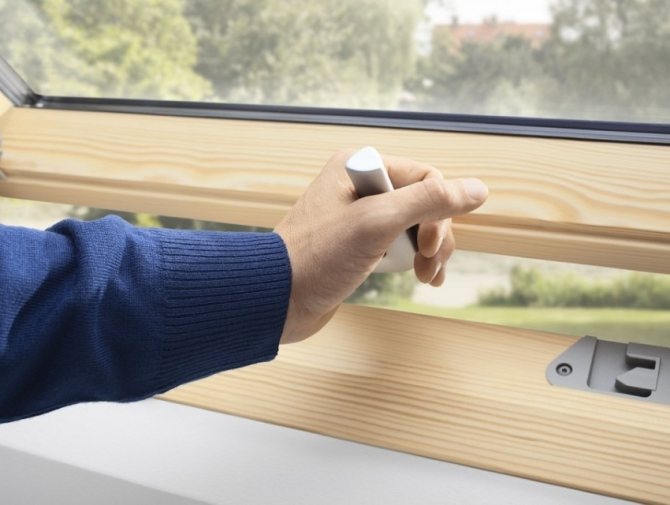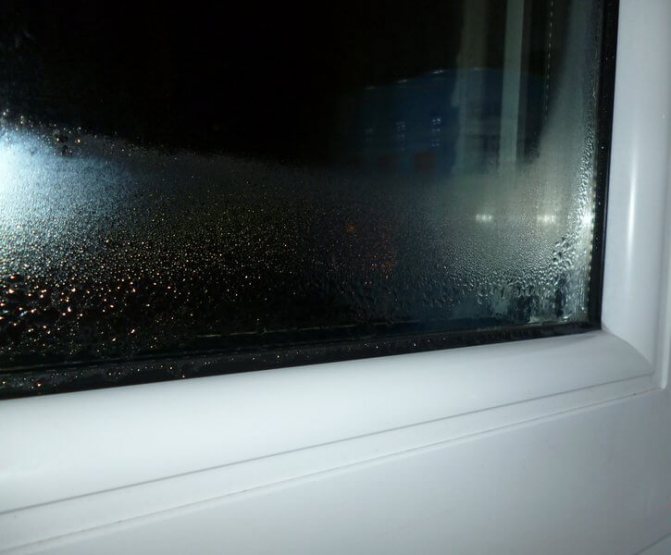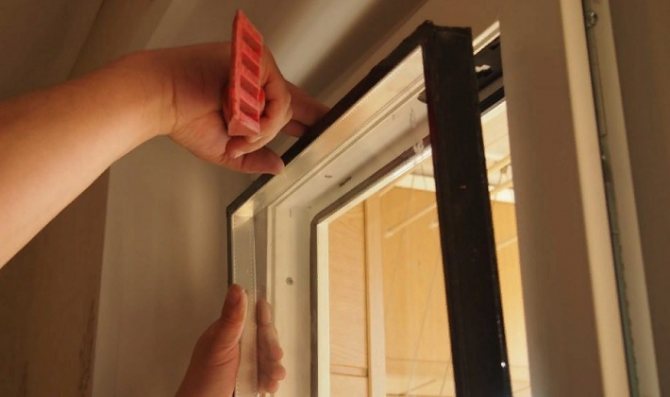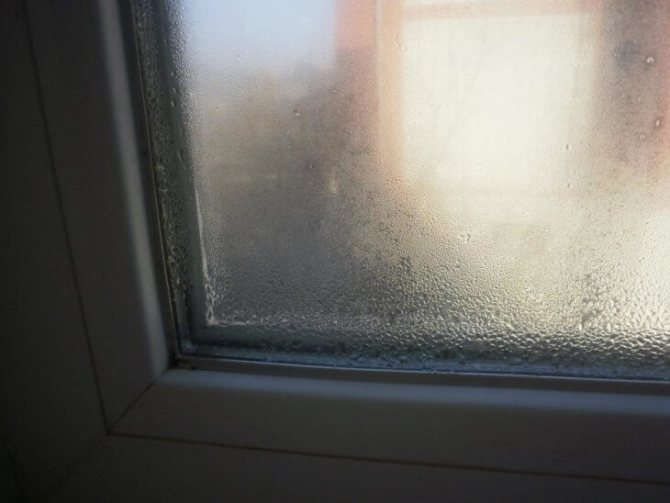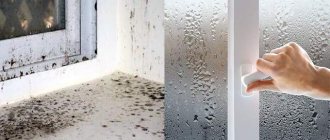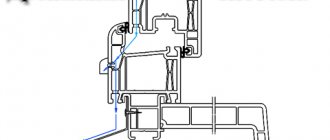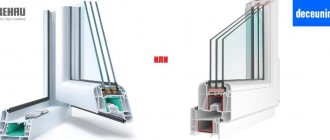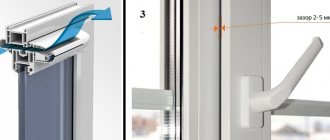Reasons for fogging windows
Excessive moisture should be mentioned first. A person by himself evaporates about 2-3 liters of water per day. And this is on average under normal conditions. Live plants in pots also give off moisture.
If we talk about an apartment or house, then the microclimate is also influenced by the use of the washing machine, cooking, taking a bath or shower. The indicator of relative humidity in residential premises should be in the range of 50-65%.
In connection with the first point, the question arises as to why excess water remains in the room. Apartments and houses usually lack good ventilation. Fresh air enters there through windows and doors and moisture is removed in the same way. This, as can be seen from practice, is not enough.
Temperature change. People notice condensation on plastic windows mostly during the cold season or in the off-season. Why is that? Condensation is affected in the same way by both humidity and temperature.
There is such a thing - dew point. This is the temperature at which the vapor contained in the air collects into water droplets, since the air cannot hold it. The surface of the glass is the coldest place in the house.
When the relative humidity is high enough, when the temperature of the glass inside the room reaches a certain level, it passes the dew point, and we get condensation on the windows. A glass vessel taken out of the refrigerator can become a demonstration of this phenomenon - the same processes take place with it.
Another factor that is directly related to temperature is the location of the house according to the cardinal points. Windows facing north will certainly be colder than the south.
Accordingly, the moisture already formed on them will evaporate much longer, which means that it will take longer to influence the glass unit itself.
Glass unit production and installation
Although the installers of plastic windows are professionals, they still get errors. Oversights are also allowed by the residents of the premises where the designs are changing. In this case, you also need to know what to do. Why do windows sweat and cry? This is due to several reasons:
- Inaccuracies during the design or manufacture of windows.
- Purchase of an unsuitable double-glazed unit.
- Poor installation.
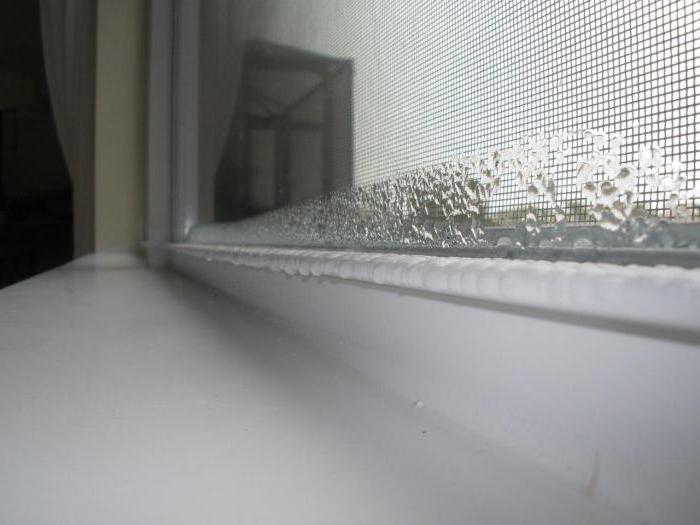
Poor quality structures need to be repaired or disposed of. Buyers should choose windows carefully. If the product will be installed inside rooms or on a loggia, it is necessary to purchase a two-chamber model. Products with 1 chamber are ideal for a room adjacent to a glazed balcony (since it does not need additional insulation).
For reasons of economy, many people choose thin glasses, but they do not adequately protect from the cold. In addition, condensation will appear on such products. When replacing plastic products with wooden ones, you need to prepare for changing the ventilation mode.PVC is a sealed material that increases the humidity inside, and there are cracks in the wood through which air is exchanged.
If you compare the plastic and wooden construction, you can find one difference - the inner glass of the former has a lower temperature, so it condenses faster. Construction errors are as follows:
- Incorrect foaming of cracks.
- The emergence of a "cold bridge" - the area of adjoining plastic or wood to the side of the wall with a negative temperature.
- Blowing masonry - appears with the destruction of horizontal or vertical joints between bricks.
If you want to purchase a durable product, it is important to control all stages of window installation. Also, do not purchase a wide window sill.
These are the main reasons why windows sweat and "cry". It is necessary to identify the cause of this phenomenon and eliminate it.
Condensate removal methods
Before describing the methods of combating condensation, little should be said about the insulating glass units themselves.
The purchase and installation of two- and three-chamber double-glazed windows, especially in regions with a cold climate, will, to a fairly large extent, help to avoid the appearance of condensed moisture on the windows.
A single-chamber double-glazed window simply will not cope with this task.
Tips and Ways:
- Provide adequate ventilation. In the absence of a normal ventilation system, you can proceed as follows: open the vents twice a day for 15–20 minutes. Simple ventilation removes used air along with water vapor and lets in fresh air. Forced ventilation has proven its effectiveness.
- It is a duct system with fans built into it. With its presence, there is no need for conventional ventilation. Even modern ventilation with the help of humidity and temperature sensors is able to regulate the microclimate in various rooms at your request: heat, dry, humidify, etc.
- The next important factor is the finishing of window slopes, window sills and external sills with their simultaneous insulation. Together, this allows you to reduce heat loss and, accordingly, move the dew point.
- You should also pay attention to the balcony. It is better to order glazing of the balcony (you can use single-chamber double-glazed windows) with simultaneous insulation of the floor, walls and ceiling of the balcony. In this case, condensation probably cannot form on the glass inside the room.
- The location of batteries and heating devices is also important. It is desirable that convectors, radiators, batteries are under windows and window sills should not completely overlap them from above. This will create a permanent thermal curtain in front of the windows. Curtains and drapes are also a barrier to heat escape. You should also be careful with open water surfaces, such as aquariums.
- Do not forget about such little-used things as shutters, roller shutters and roller shutters. Since an air gap forms between them and the windows, we get an additional barrier to heat loss. Door roller shutters, among other things, can perform an aesthetic function, because they are produced according to individual orders and can be painted in different colors, carry photo printing, and so on.
Together, these methods will help get rid of the unpleasant condensation problem and even avoid unnecessary heating costs.
Source: steklandia.ru/poleznoe/problema-kondensata-na-steklopaketah/
Wooden windows
Wood allows air to pass through better, therefore, less condensation appears on such structures. But if fogging occurs, then in order to get rid of the problem, it is necessary to take into account how they were insulated. To normalize the microclimate in a room with double-glazed windows made of wood, you need to follow simple recommendations:
- Remove the seal and polyurethane foam from the upper part of the frame, look at the condition of the glass. If condensation appears, it is necessary to leave the window frame without the removed parts until it dries out completely. To speed up the process will allow blowing with a heat gun, a fan with warm air.
- Condensation can occur due to improper installation of heating radiators or their poor quality. Often, windows sweat and cry due to the fact that the heating system is far away. To eliminate condensation, you should transfer it to the double-glazed windows.
- Wood is considered to be more sensitive to air currents than plastic. Drops on the glass may appear due to the fact that the door to the room is not closed or the tap is leaking. Avoid such penetration of moisture into the air.
- Washed clothes that dry on batteries also have a negative effect on windows.
- Blackout curtains that darken the room increase the chance of condensation.
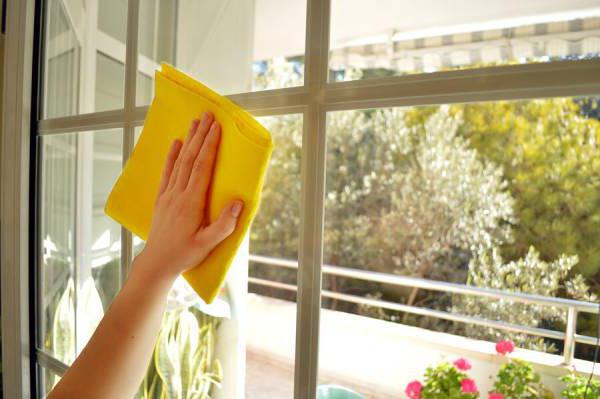

It should be borne in mind that wooden window products are better than PVC, as they form little moisture on the glass. Their surface structure transmits and distributes heat evenly.
We fight condensation on plastic windows
Condensation is the most common problem faced by PVC window manufacturers and their customers.
It should be noted that condensation is not only an unpleasant aesthetic defect, but it can cause moisture in building structures, and as a consequence of the appearance of mold!
According to the norms, the temperature of the indoor air in the premises must not be lower than + 18 ° С; in a number of regions, the Territorial Building Standards (TSN) have been adopted, which prescribed the temperature of living quarters not lower than + 20 ° С.
If the temperature is below the standard, then it is necessary to check the heating system, because this can cause condensation to fall out.
Condensation occurs primarily at the bottom of the glass unit. Due to convection, cold air accumulates in the lower part between the glass panes.
Therefore, the bottom and bottom corners of the glass unit are the coldest parts of modern window construction.
Since the question of the marginal zone often arises, the State Construction Committee of the Russian Federation gave an explanation on this problem in letter No. 9-28 / 200 of 03/21/2002:
1. The fallout of condensate in the edge zones on the inner surface of glass units during the winter period of operation, as a rule, is associated with the presence of an aluminum spacer frame in their structure and the conditions of convection of gas-air filling.
International norms (ISO, EN standards) allow temporary formation of condensation on the internal glass of an insulating glass unit.
But the standards for window blocks do not normalize the formation of condensation, since this phenomenon depends on a set of third-party factors: air humidity in the room, design features of the junction points of window blocks, insufficient air convection along the inner glass (due to a wide window sill board, improper installation of heating devices ) and etc.
At the same time, GOST 24866-99 does not allow condensation to occur inside the glass unit, which should be considered a significant defect leading to a decrease in the standardized performance characteristics.
As for the increased air humidity, this phenomenon is characterized by the following main reasons:
- Insufficient air exchange due to too tight windows and, as a result, poor operation of the exhaust ventilation.
- Increased humidity in building structures due to recently completed construction or renovation work. Building structures retain moisture for one to two years after the end of the work!
- Features of the everyday behavior of residents. For example, a greenhouse on the windowsill or drying baby diapers in the kitchen ...
New norms SNiP 23-02-03 “THERMAL PROTECTION OF BUILDINGS” determined the calculated parameters of the relative humidity of the premises to determine the dew point and the temperature requirements on the inner surface of the windows:
5.9 The relative humidity of the internal air to determine the dew point temperature in places of heat-conducting inclusions of enclosing structures, in corners and window slopes, as well as skylights, should be taken:
- for premises of residential buildings, hospitals, dispensaries, outpatient clinics, maternity hospitals, boarding houses for the elderly and the disabled, general education schools for children, kindergartens, nurseries, day nurseries (factories) and orphanages - 55%, for premises kitchens - 60%, for bathrooms - 65%, for warm basements and underground floors with communications - 75%;
- for warm attics of residential buildings - 55%;
- for premises of public buildings (except for the above) - 50%.
5.10 The temperature of the inner surface of the structural elements of the glazing of windows of buildings (except for industrial buildings) should not be lower than plus 3 ° C, and of opaque elements of windows - not lower than the dew point temperature at the design temperature of the outside air in the cold season, for industrial buildings - not lower than zero ° C.
What other mistakes can lead to condensation? Check the room for a cold surface!
The reasons for the appearance of cold surfaces can be associated with resistance to heat transfer and with the blowing of structures. They can be as follows:
Errors in the manufacture of windows:
- Installed "cold" double-glazed window with low resistance to heat transfer, which does not meet the standards.
- Violation of the clearance tolerances, the use of a non-standard seal or improper installation of the hinges are the reasons leading to the blowing of the window.
- In the non-opening sashes, drainage holes of 5x20 mm are made instead of holes for draining the cavity between the edges of the glass units and the folds of the profiles with a size of 5x10 or with a diameter of no more than 8 mm.
That is, we are talking about a violation of the provisions of GOST 30674-99, clause 5.9.5 and clause 5.9.6 on the system of ventilation and drainage holes. We sent a letter on this topic, and we want to remind you again: according to GOST, there are drainage holes, and there are ventilation holes. These are different types of holes!
In the letter of the Gosstroy of Russia No. 475 dated 09/10/02 in clause 2 it is stated that “if the doors are not opening, the dimensions and location of the holes in the lower profile of the box should not contribute to hypothermia of the lower edge of the glass unit”.
The confusion in this matter is often associated with terminology: in GOSTs there is no concept of "fixed" glazing or a window, but there is the concept of "non-opening sash"!
That is, in the version that in everyday speech we call a "blind window or glazing" in the terminology of the norms - "not opening sash"!
Physical properties of condensate
Ice becomes water due to heating, and the opposite process occurs with decreasing temperature. It is called moisture condensation. High temperature air contains liquid in the form of vapor. The situation changes with cooling. Air cannot hold a lot of liquid, as it decreases in volume, and moisture remains in areas with a lower temperature.
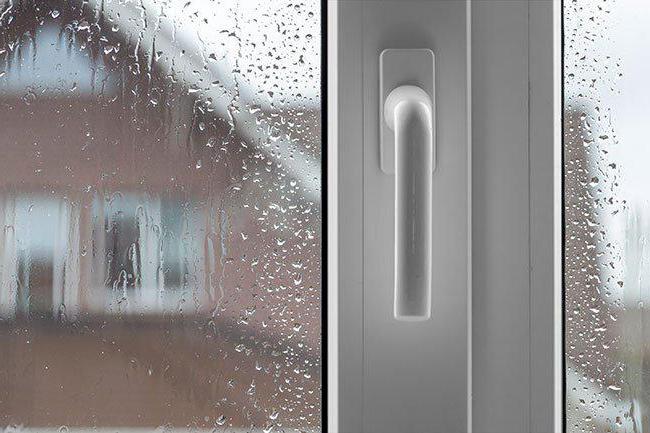

The glass of the window is considered the coldest place in the house, since it borders the street, so condensation appears on it. At very low temperatures outside, it becomes ice. At first glance, it may seem that condensation is not dangerous. But with the frequent formation of liquid, construction products get wet, after which the rigidity of the structure is weakened and the formation of mold. Therefore, it is important to know why the windows in the house "cry", as well as how to fix it.
Installation errors
- Errors in the execution of the assembly seam: incomplete foaming, which reduces the resistance to heat transfer; poor protection against climatic influences outside, which leads to blowing or wetting of the foam; absence or poor vapor barrier, which also leads to wetting of the insulation, but already with steam from the side of the room.
- “Cold bridge”, when, due to improper design of the junction unit, the window falls into the cold, sometimes even negative temperature zone of the wall. This reason is often encountered when profuse condensation occurs.
- Blowing through a wall structure, for example, a brick wall, through empty joints - "wasteland". This phenomenon can be encountered on the houses of the socialist period - the builders did not fill the vertical seams well. But this has also become a problem in new construction with multi-layer walls, when mineral wool is covered from the outside with bricks or other cladding. In this case, the insulation must be ventilated, and when the windows are placed in the plane of the insulation, they may be exposed to cold air from the side of the junction. In this case, it is better to separate the wall from the junction during installation with a layer of expanded polyethylene with a thickness of 6-10 mm.
- The wide window sill prevents warm air convection from the radiator in the window opening.
Therefore, we can give the following tips to eliminate the possibility of condensation:
- If, nevertheless, condensation has become a consequence of increased air humidity, then this reason must be eliminated due to an increase in the likelihood of mold in the room.
- To lower the air humidity in rooms and transfer the dew point to lower temperatures, we recommend installing a Regel-Air climatic valve or ventilating the room for 10 minutes twice a day.
- Heat losses with such ventilation are insignificant even in winter and amount to no more than 3 degrees.
- The intensity of ventilation of the room must be increased when carrying out repair work.
- The window sill should not be very wide and prevent the passage of warm air.
- To allow warm air to pass to the window, place the curtains at some distance from the window sill.
- Decorative screens for heating radiators should not impede the passage of heat fluxes from radiators.
- The exhaust ventilation system in your home or apartment should be checked periodically.
One of the most effective ways to combat condensation will be the installation of a window with a five-chamber system "Favorite", developed by "THYSSEN POLYMER GmbH" (Germany) especially for Russia.
The temperature on the inner surface of the profiles directly depends on the heat transfer resistance of the profile system. For example, we can consider two cases - at an external temperature of -26 ° C and at -31 ° C (at an internal temperature of +20 ° C and a relative humidity of 55%).
In this case, the dew point will be +10.7 ° C. The temperatures on the surfaces of a typical binding (three chambers and a width of about 60 mm) and a five-chamber binding with a heat transfer resistance of 0.78 m2? C / W will be as follows:
| Binding option | The temperature on the surface of the binding at an external temperature of -26 С | Temperature on the surface of the binding at an external temperature of -31 С |
| Binding from 0.63 m2 C / W | 11.82 C | 9.79 C |
| Binding from 0.78 m2 C / W | 13.22 C | 12.48 C |
Source: ashdom.ru/articles/fenstr_1.htm
Window sill
A wide window sill above the heating system interferes with proper air circulation. This may also be one of the reasons why windows "cry". The required heat is not supplied to the structure, and when cooled, water appears on it.
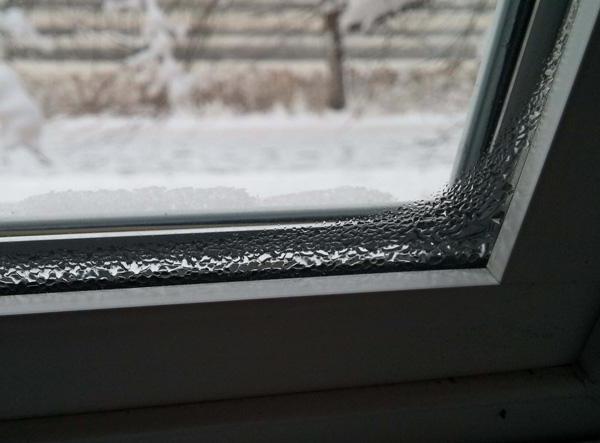

This problem can be eliminated by reducing the window sill so that warm air from the battery is directed to the window. If possible, pull out the heating radiator. It is even more convenient to find another method of heating the window.
Why plastic windows sweat from the inside and how to fix it
If a double-glazed unit fogs up not outside, but between the glasses, then there can be only one reason - a marriage of double-glazed windows. This is the manufacturer's fault, since the glass unit must be airtight.
This problem is solved simply by replacing the glass unit (only it, and not completely the entire window structure - the profile remains the same). A double-glazed window is installed for several minutes - for this, the glazing beads are removed.
It is clear that this work should be carried out by specialists. In addition, if you contacted a qualified company, then the replacement of a defective leaking glass unit will be free of charge - after all, this marriage is covered by a guarantee (it must be spelled out in the contract).
If the windows constantly fog up, then a single-chamber double-glazed window may be to blame. Experts generally do not recommend using them in living quarters, since they do not retain heat well enough.
This happens due to the fact that only one interlayer is provided in the profile, as well as due to the minimum distance between the glasses. Saving is not welcome here, especially since the service life of high-quality plastic windows is measured in decades.
Step-by-step instruction
If you find an accumulation of water on the windowsill, do not be upset. Use the step-by-step instructions, following which you will receive a completely serviceable window in the near future without the hassle and serious additional costs:
- Call in and arrange a visit to the master at a convenient time for you. While you are waiting for a specialist, wipe the window with a dry soft cloth so that water does not destroy the structure.
- The foreman will come with everything necessary to diagnose the window and establish the causes of the leaks. The inspection usually does not take long.
- If the situation can be resolved with a simple adjustment, it will be done on site. Otherwise, a specialist will advise on further actions and calculate the cost of repairs. If the client is satisfied with everything, a service agreement is signed.
Reasons for fogging plastic windows
There can be many reasons why plastic windows sweat from the inside. And to fix the problem, you can't do without identifying the reasons. So, the problem may arise due to:
- An increase in humidity in the air in the room - for example, when cooking, drying clothes, and so on.
- Disturbance of air circulation in the apartment. If in winter the batteries are only slightly warm, and it is very cold outside, then the plastic windows cannot warm up to the proper degree.
- If the batteries are hot, and the windows still fog up, you need to check the window sill - it may turn out that its too large overhang is blocking the supply of heat to the window sill. Protective screens on batteries can also lead to this - after all, this way the heat spreading through the apartment does not cover the lower part of the window, which is why condensation forms here.
- Lack of high-quality ventilation - it may become clogged or not work at all, so that moist air is not extracted.
- Plastic windows can fog up if the apartment or balcony is being renovated, or immediately after its completion. After all, all freshly laid finishing materials (wallpaper and even ceramic tiles) emit a large amount of moisture into the room, which will settle on the windows.
Incorrect installation of the plastic window. This means that your windows were installed with a gross violation of technology - poor-quality sealing of the gap between the profile and the window opening.
In addition, the ebb is very often installed incorrectly - just screwed to the window. The ebb should be placed on a previously prepared base from a solution - this will create an airtight layer, protect against moisture and cold, as well as from noise in case of strong wind.
The window can also be installed with a violation of the level - the resulting distortion leads to the fact that the sealing gaskets of the window sashes do not fit tightly.
Poor-quality fittings can also play a role - because of it, the window sashes will not close tightly. Fittings installed in violation of the rules will lead to the same effect.
Improper performance of work on the insulation of external or internal slopes. They must be insulated and this should be done efficiently.
Styrofoam is suitable as an external insulation.You should also use a cement mortar - it is used to seal the cracks in the places where the window adjoins the opening. When working with internal slopes, foam is not used - here preference is given to a basalt slab or glass wool (mineral insulation).
A poor-quality sealant - then a gap appears between the glass unit and the frame through which cold air passes.
Incorrect adjustment of the plastic window - insufficient fit of the sashes, improperly installed fittings, and so on.
Ventilation
Even after installing a new window, smudges on the glass and puddles on the windowsills often appear. Why do plastic windows "cry" and what to do in this case? The main task is to normalize the indoor climate. It is necessary to reduce humidity and ensure heating of the inner glass (if the package is two-chamber).
First you need to check if the ventilation is working. The system must remove humid air. With clogging, it accumulates inside and then settles on the windows. Probably, there is dust, dirt inside the air conditioning system, which makes all the work difficult. It is not difficult to check the level of clogging - you need to bring a lighted match or lighter to the outlet. If the fire goes out or hesitates, then the ventilation works, otherwise it needs cleaning.
How to eliminate fogging of plastic windows - we solve the problem
To prevent plastic windows from fogging up, a number of preventive measures can be taken. So, if the window is already installed and the problem does not bother you very much, then follow two simple steps:
- Remove any houseplant pots from the windowsill. Plants and moist soil both cause condensation.
- Ventilate the apartment regularly - especially if the humidity in it temporarily rises for some reason.
If you are just planning to install a plastic window, then immediately check that all work is carried out carefully and in accordance with the technology:
- choose at least a high quality 2-chamber glass unit, ideally with an energy-saving film. The best option is considered to be a vacuum glass unit;
- carry out high-quality work on the insulation of slopes: the polyurethane foam is carefully sealed both from the inside and outside of the room, and then a suitable insulation is added;
- the place of attachment of the low tide is also covered with cement and insulated with foam;
- the place where excess foam emerges from under the windowsill is also carefully putty - this eliminates the effect of cold in this area.
As for the main recommendations for eliminating condensation on plastic windows, they are as follows:
- if the outside air temperature allows it, it is advisable to keep the windows on the "airing" mode all the time;
- constantly use the hood in the kitchen during the cooking process, regularly ventilate the premises;
- reduce the width of the window sill or move the battery away from the wall, install convection grilles in the window sill or drill holes. It may also be necessary to remove the decorative grilles;
- check the efficiency of the apartment ventilation - a thin sheet of paper should stick to the ventilation grill. If this does not happen, the ventilation system requires cleaning;
- if a defect is found in the construction of a metal-plastic window or inconsistencies in the technology of its installation are admitted, contact the company that carried out the work - their responsibilities include eliminating inconsistencies;
- regularly check the wear of the fittings - adjustment or replacement of components may be required;
- do not forget to transfer metal-plastic windows into winter operating mode. This requires a hex wrench - it is inserted into the eccentric at the end of the window, and then turned.
As you can see, there are two main reasons why condensation collects on plastic windows - either incorrectly carried out work on the installation of a metal-plastic structure or its marriage (wear), or too high humidity in the room.
So if you choose a quality product and check the correct installation, then there is a high probability that the windows will not fog up.
And if you also ensure the observance of the temperature regime and high-quality ventilation of the balcony, then the problem will be finally solved - you will forget about unpleasant drips on the glass and dampness.
Source: balkonsami.ru/osteklenie/montazh-i-remont/pochemu-plastikovyie-okna-poteyut-iznutri.html
Using heating appliances
Since one of the ways to reduce fogging is to heat the window surface, you should always place radiators under the windows.
In this case, in addition to the ventilation device, it is advisable to install a convector under the French window, which is installed directly into the floor. It can be both electrical and water. During its operation, warm air rises directly over the window glass, heating it and preventing the formation of condensation.
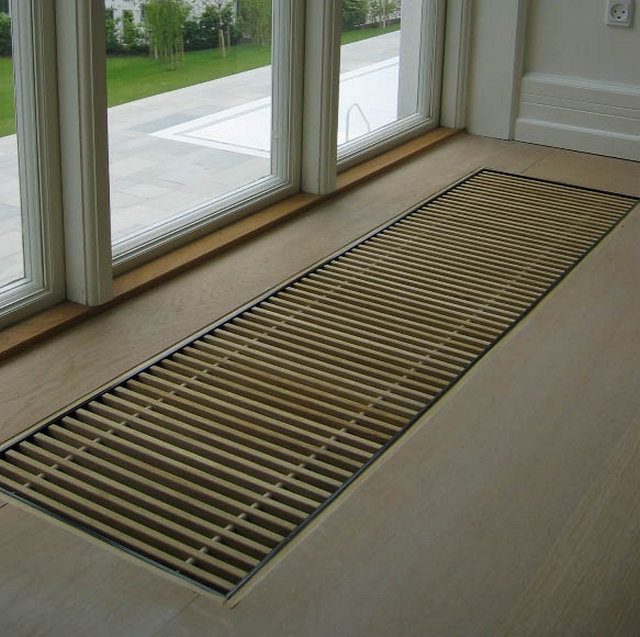

The same option can be used to heat conventional windows. But since most often there is a window sill between the heating device and the window, which blocks the flow of hot air, you can use special transfer grilles. They cut into the window sill as close to the glass as possible.
What to do if the windows in the house sweat
So, we found out that windows in a private house sweat for two reasons: humidity and low glass temperature. Accordingly, the struggle for the microclimate is reduced to an increase in temperature and a decrease in humidity.
You can increase the temperature of the glass in the following ways:
- We are replacing old windows with plastic 2-chamber windows with energy-saving glass. If plastic windows have already been installed, then you can simply replace the double-glazed windows with more energy efficient ones. (radical but effective way)
- We dismantle the windows and install them with a shift towards the room. (also a radical way)
- Window sills should not interfere with proper air convection. Make sure the window sill does not overlap the battery by more than 2/3.
- Make sure the blackout curtains do not block the batteries.
- Raise the temperature in your home.
We fight moisture in the following ways:
- We check the operation of the hood, if any. If there is no hood, then it is better to make one. While there is no hood or it does not work effectively, you can open the damper in the fireplace - the chimney draft can partially play the role of the hood.
- Provide an inflow of fresh air, for this, install supply valves on all window sashes, or turn on micro-ventilation mode in the windows (if there is one), just open the window slightly to ventilation mode.
- Get rid of sources of moisture (get rid of leaks, potted flowers, aquarium, etc.)
- Make sure that the interior doors are not airtight and have at least 2-3 cm gaps between the door leaf and the floor.
- Ventilate your home regularly.
We figured out why plastic windows in a private house sweat and how to deal with this phenomenon.
Source: okna-lider.com/pochemu-poteyut-okna-v-chastnom-dome/
Two of the easiest ways to get rid of window "tears"
Does the above mean that you shouldn't install double-glazed windows in your house? Everyone makes such a decision himself, comparing all the advantages and disadvantages of both options, as well as getting acquainted with the ways to get rid of condensate on their inner surface. For example, the easiest way to get rid of the fogging of PVC windows is to regularly ventilate the premises. It can be produced either by installing the handle on the frame in the ventilation position (if this is provided for by the design of a particular model), or by opening the windows for 5 minutes every 2-3 hours.At the same time, it should be understood that the second option will lead to great heat loss and is not suitable for those who disappear at work all day. As already mentioned, one of the reasons why plastic windows "cry" is poor convection. To eliminate it, it is enough to make a few holes in the window sill, allowing warm air to heat the glass and reduce the “dew point”, and you should also, at least in the cold season, abandon the curtains and shutters mounted directly on the frame.
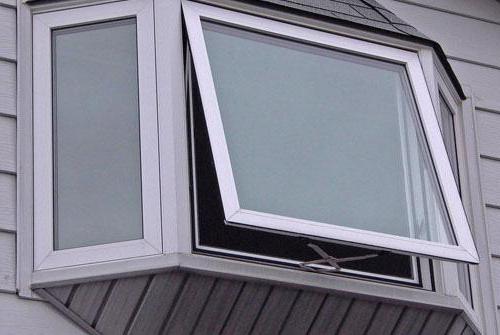

Leaky plastic windows in the rain
If it happens that during the rain, water flows through the plastic windows, and you do not know what to do. Do not rush to panic, we will help you fix this trouble, and we will show you what causes moisture to penetrate.
Reasons for leaking windows:
- Installation errors. Most likely, even during the installation of the window, the technology of insulation and sealing of the seams was violated and because of this the plastic window is leaking.
- The seal has lost its properties, is depleted, dried out. But this only happens if a long time of use of the sealing gum has passed.
- Incorrectly made slopes.
- There is little or poor quality foam in the openings.
- The drain is poorly inserted, or it cannot cope with such a volume of water, or it is clogged altogether.
- In addition to the leakage of a plastic window during rain, there is another cause for concern - this is rubbing and fogging of the glass from the inside, the appearance of condensation.
Reasons for the appearance of moisture inside PVC windows:
- Low-quality double-glazed windows. Often unscrupulous manufacturers make it from cheap and low-quality materials, subsequently the glass unit does not fully fulfill its heat-shielding function, the glass freezes and condensation appears.
- Insufficient ventilation. You just need to skillfully use the micro-ventilation mode, ventilate the rooms regularly, 10-15 minutes of ventilation a day will be enough.
- High humidity in the house. Especially in the kitchen, when cooking or boiling water.
- Improper installation, the window is blown out in places and moisture loss is inevitable in winter.
- If a window leaks during repairs, then this is normal, because building materials contain moisture and gradually release dampness to the air.
Causes of condensation
One of the functions of wooden or plastic windows is to protect the premises from freezing. However, the products do not always fulfill their purpose properly, since they are used incorrectly. The following are common causes of condensation:
- significant temperature difference inside and outside the house;
- high humidity in the room;
- too wide a window sill above the battery;
- poor ventilation (clogged);
- non-observance of the operating modes of windows (some double-glazed windows have two modes - winter and summer);
- the room is rarely ventilated (or never);
- the wrong window is selected for a certain room;
- the presence of plants on the windowsills.
There is another group of reasons that contribute to the formation of moisture on glass. We are talking about errors in the production of windows, as well as inaccuracies during the installation of double-glazed windows. These factors will be considered in more detail below.
